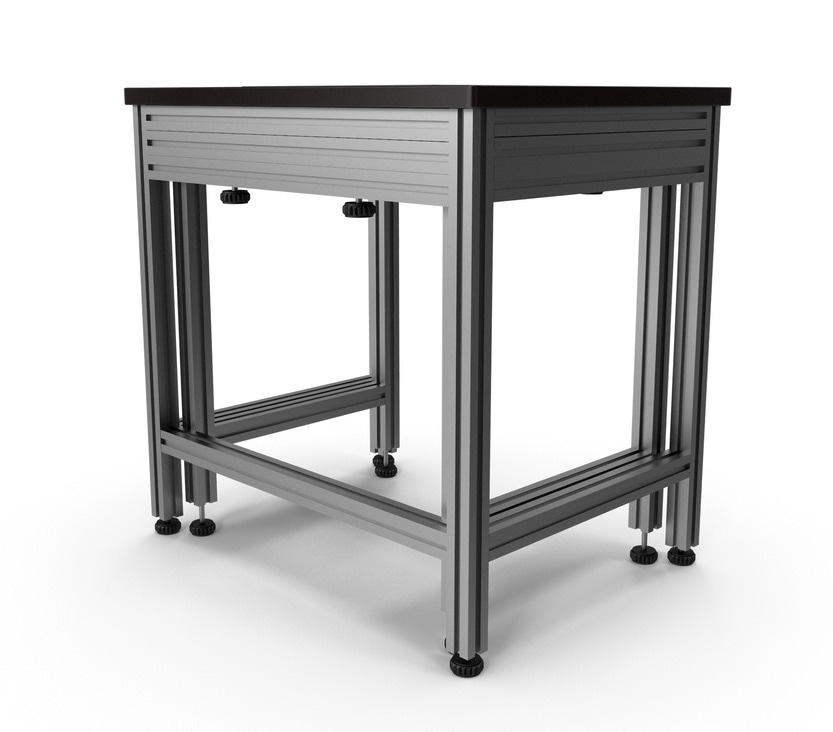The accuracy of imaging results is influenced by several external factors, including movements that cause vibrations around the samples. Equipment such as anti-vibration tables plays a critical role in reducing vibrations and ensuring safety, consistency, and quality to produce highly precise results. This article discusses anti-vibration tables and their importance for accurate sample imaging.

Image Credit: Nayeemislam25/Shutterstock.com
What are Anti-Vibration Tables?
Anti-vibration tables, or vibration isolation tables, are primarily specialist work surfaces used to reduce disturbances and vibrations significantly while conducting scientific and testing analysis and precise weighing experiments in lab environments using extremely sensitive high-precision equipment such as microscopes and laboratory balances.
In microscopy, anti-vibration tables are utilized to stabilize the images, specifically while using laser scanners and during long-term high-resolution exposures. Similarly, the tables can prevent inaccurate measurements of section flatness and thickness in ultramicrotomy.
Anti-vibration tables are built using shock-absorbing materials such as rubber, steel, and granite and possess a solid, robust surface to negate movements and vibrations caused by adjacent drafts and construction work, passing vehicles, operator error, seismic activity, nearby machinery operations, air currents, and footsteps.
Among these vibrations, suppressing low-frequency vibrations such as traffic is extremely difficult. Moreover, labs located at the top of a building also experience horizontal vibrations caused by wind sway, which can lead to inaccuracies in the results.
Working Principle of Anti-Vibration Tables
Anti-vibration tables decrease the effects of vibration by suspending a dense mass on which the device is placed. The dense mass, primarily shock-absorbing materials, can absorb local vibrations in the lab to ensure accurate sample imaging by minimizing errors.
These materials prevent the transfer of motion between the weighing surface and the tabletop/floor. A rubber mount is used to separate the weighing surface from the tabletop to suppress the vibrations.
In several instances, the frame used to suspend the dense mass is surrounded by a second frame to eliminate the effects of operator errors, such as accidentally bumping into the anti-vibration table. Adjustable feet can also be used to stabilize the anti-vibration table.
Types of Anti-vibration Tables
Passive and active anti-vibration tables are the two major types of anti-vibration tables. Passive anti-vibration tables are primarily designed to decrease vibrations using specialized construction techniques and dense materials, such as marble and granite, which can dampen the vibrations. In these tables, shock absorbers can be adjusted to decrease the effect of uneven weight distribution.
Moreover, a 5-6 bar compressed air connection through a compressed air bottle, a quiet compressor, or a house line is also required to operate the passive anti-vibration tables. Although passive anti-vibration tables can effectively reduce low-frequency vibrations, they are ineffective in reducing high-frequency vibrations.
Active anti-vibration tables require a stable and flat base and a standard power connection for operation. These tables use feedback systems and sensors to actively nullify the vibrations in real-time. The sensors detect the vibrations and transmit the information to a controller, which then adjusts the actuators of the table to counteract the vibrations.
Active anti-vibration tables can effectively reduce both high-frequency and low-frequency vibrations and are suitable for environments with constantly changing vibrations.
Scientific devices such as laser scanning microscopes can be placed on passive systems, while actively isolated tables possessing integrated active vibration control (AVC) features can be used on a large scale for ultra-sensitive applications.
Both active and passive anti-vibration tables are available in different designs and sizes based on specific user requirements. The major anti-vibration table designs include freestanding anti-vibration tables and tabletop anti-vibration tables.
Freestanding tables consisting of a heavy-duty base with a solid top plate are utilized for larger equipment and can be placed directly on the floor. Portable and smaller tabletop anti-vibration tables containing a compact base with a smaller top plate are used for smaller equipment, such as microscopes.
Applications of Anti-vibration Tables
Anti-vibration tables are used in professional medical institutions, pharmaceutical production labs, university science labs, and food testing facilities for accurate chemical analysis, food sample testing, and sensitive scientific research.
Recent Developments
Optical tables are used extensively to insulate devices from load disturbances from the equipment and ground disturbances from the environment. These disturbances can be controlled independently using disturbance response decoupling (DRD) techniques.
For instance, ground disturbances can be isolated using soft passive suspensions, while the load responses can be improved using active control. However, the passive elements cannot be adjusted easily based on operating conditions.
In a paper published in the Journal of Vibration and Control, researchers developed a new mechatronic inerter network to isolate vibrations of a full optical table. Initially, the ground responses were optimized by connecting the networks to suitable electric circuits.
Subsequently, DRD techniques were applied to improve the load responses without affecting the ground responses. The findings of this study demonstrated the effectiveness of the proposed DRD structures and mechatronic inerter networks in improving the system responses.
View Motion Control Equipment Here
References and Further Reading
Wang, C., Wu, Y. (2014). Vibration control of an optical table employing mechatronic inerter networks. Journal of Vibration and Control. https://doi.org/10.1177/1077546314528365
ALL YOU NEED TO KNOW ABOUT ANTI-VIBRATION PLATFORMS [Online] Available at https://www.scienceservices.eu/focus-on-anti-vibration-plattforms (Accessed on 20 July 2023)
Using an Anti-vibration Table [Online] Available at https://www.inscale-scales.co.uk/blog/using-an-anti-vibration-table#:~:text=Anti%2Dvibration%20tables%20are%20simple,on%20which%20the%20table%20stands. (Accessed on 20 July 2023)
Robinson, C. (2022) Anti-vibration tables: a solution to increasing laboratory balance accuracy [Online] Available at https://camblab.info/anti-vibration-tables-a-solution-to-increasing-laboratory-balance-accuracy/ (Accessed on 20 July 2023)
Disclaimer: The views expressed here are those of the author expressed in their private capacity and do not necessarily represent the views of AZoM.com Limited T/A AZoNetwork the owner and operator of this website. This disclaimer forms part of the Terms and conditions of use of this website.